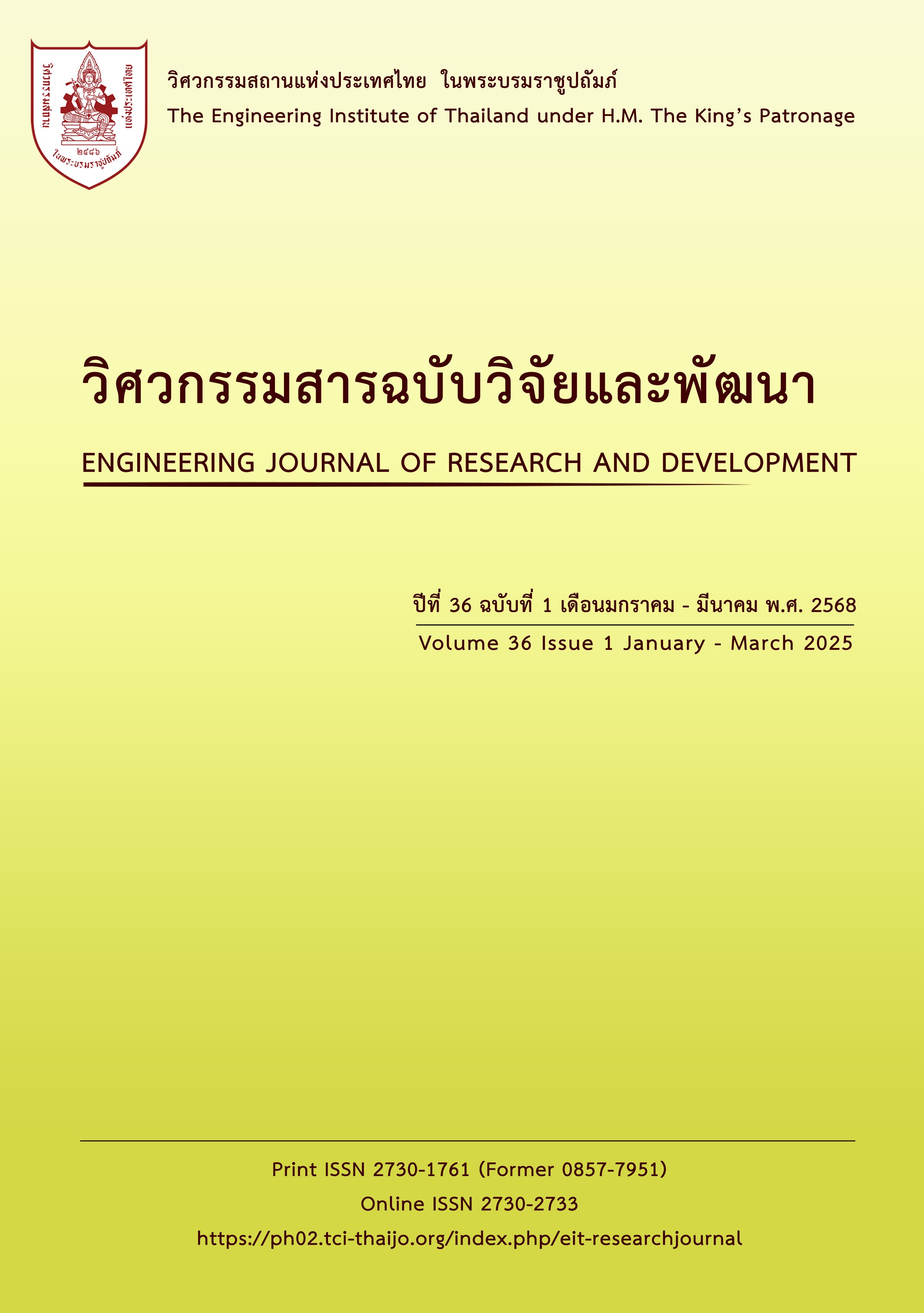Strength Development of Sugar Cane Bagasse Ash Stabilized by Cement for Road Construction Works
Main Article Content
Abstract
This study investigated the development of compressive strength of sugar cane bagasse ash (SCA) mixed with cement. Sugar cane bagasse ash is the by-products from sugar industry. In this study, the material SCA was brought from Sugar Power Plant Company Limited. The set of modified compaction of SCA mixed with cement at 2% upto 10% were performed. The compaction results showed that the maximum dry density (MDD) was measured between 1,335 kg/m3 and 1,490 kg/m3 and the average amount of optimum water content of 25% was reported. This amount of water content at 25% was to be used in preparing specimens for unconfined compression tests (UCS tests). The strength tests included the SCA specimens mixed with cement at 4%, 6%, 8% and 10% with the curing periods of 7 days, 14 days and 28 days. As a results of cementation by hydration of cement and water, the UCS test results showed that the strength increased with increasing the amount of cement and curing periods. At the certain amount of cement, this study proposed the relationship between the values of unconfined compressive strength (qu) and curing time (t). Also, with the cement content at least 6% at the curing age of 7 days, the test results showed that the specimens had strength more than 7 kg/cm2 satisfying the requirement for subbase course. However, specimens with the cement content of 4% required the curing period at least 21 days to develop the strength upto 7 kg/cm2 for the subbase course. In addition, the results suggested the use of 10% cement content at the curing time of 28 days to satisfy the strength at 17.5 kg/cm2 according to the DOH standard for the base course materials. Therefore, the study results recommended that SCA mixed with cement be the materials with values added for civil engineering works with the potential to be used as material substitution for road constructions.
Article Details

This work is licensed under a Creative Commons Attribution-NonCommercial-NoDerivatives 4.0 International License.
The published articles are copyright of the Engineering Journal of Research and Development, The Engineering Institute of Thailand Under H.M. The King's Patronage (EIT).
References
สำนักงานคณะกรรมการอ้อยและน้ำตาลทราย (2558). “รายงานการผลิตอ้อยและน้ำตาลทราย ปี 2558” กองอุตสาหกรรมและน้ำตาลทราย กระทรวงอุตสาหกรรม ประเทศไทย กรุงเทพมหานคร.
ทวีศักดิ์ ปิติคุณพงศ์สุข และ สุนิต ประเวระทัง (2563). “ศักยภาพการนำเถ้าชานอ้อยผสมซีเมนต์มาใช้ทดแทนวัสดุในงานทาง” วิศวกรรมสารฉบับวิจัยและพัฒนา ปีที่ 31 ฉบับที่ 4 เมษายน ถึง ธันวาคม. หน้า 83 ถึง 93.
ชัย จาตุรพิทักษ์กุล (2555). “การใช้เถ้าชานอ้อยเพื่อเป็นวัสดุปอซโซลานในงานคอนกรีต” วารสารคอนกรีต (TCA e-magazine). สมาคมคอนกรีตแห่งประเทศไทย ฉบับที่ 11. กรุงเทพฯ. หน้า 1 ถึง 11, จำนวน 11 หน้า.
สุวิมล สัจจวาณิชย์ (2546). “ผลกระทบของเถ้าชานอ้อยในลักษณะวัสดุประสาน” วิศวกรรมสาร มก. ฉบับที่ 48 เดือน ธันวาคม ถึง มีนาคม คณะวิศวกรรมศาสตร์ มหาวิทยาลัยเกษตรศาสตร์. หน้า 18-22.
ปรีชา เกียรติกระจาย (2532). “การใช้ประโยชน์จากชานอ้อย” วารสารน้ำตาล 25. 5. เดือน กันยายน ถึง ตุลาคม กรุงเทพฯ. หน้า 13-19.
Abdulmatin, A., Tangchirapat, W. and Jaturakpitakkul, C. (2018). “An Investigation of Bottom Ash as A Pozzolanic Material” Construction and Building Materials 186 (2018). pp.155–162
จิรวัฒน์ วิมุตติสุขวิริยา (2560). “คุณสมบัติเถ้าชานอ้อยผสมซีเมนต์และหินฝุ่น” การประชุมวิชาการเสนอผลงานวิจัยระดับบัณฑิตศึกษา ครั้งที่ 2 มหาวิทยาลัยราชภัฏมหาสารคาม (RMU GRC 2017). มหาสารคาม. หน้า 542-547.
ASTM C618 (2015). “Standard specification for coal fly ash and raw or calcined natural pozzolan for use in concrete” ASTM International, West Conshohocken, PA.
ธีระชาติ รื่นไกรฤกษ์ (2539). “เอกสารทางวิชาการ การปรับปรุงคุณภาพวัสดุและปัญหาในประเทศไทย เรื่องการ ปรับปรุงคุณภาพดินโดยผสมซีเมนต์” ภาควิชาวิศวกรรมโยธา สถาบันเทคโนโลยีพระจอมเกล้าธนบุรี กรุงเทพมหานคร
ทวีศักดิ์ ปิติคุณพงศ์สุข (2556). “การปรับปรุงหินคลุกด้อยคุณภาพเพื่อนํามาใช้เป็นวัสดุงานทาง” วิศวกรรมสารฉบับวิจัยและพัฒนา ปีที่ 24 ฉบับที่ 3 เดือน กรกฎาคม ถึง กันยายน. หน้า 1 ถึง 7.
ทวีศักดิ์ ปิติคุณพงศ์สุข, สุนิต ประเวระทัง, สิรวิชญ์ สีหา, ธนนนท์ ฉายาพงศ์, พรเทพ แข็งขัน และ กฤต อินทรกุล (2563). “พฤติกรรมการบดอัดและกำลังอัดของหินปลายตะแกรงผสมเถ้าชานอ้อยและซีเมนต์” การประชุมทางวิชาการของมหาวิทยาลัยเกษตรศาสตร์ ครั้งที่ 58, กรุงเทพฯ, 5-7 ก.พ. 2563, หน้า 335 ถึง 343
สุวิมล สัจจวาณิชย์ และ อาทิมา ดวงจนัทร์ (2547). “ดัชนีความเป็นปอซโซลานของเถ้าชานอ้อยและความต้องการน้ำ” เอกสารการประชุมวิชาการคอนกรีตแห่งชาติครั้งที่ 2 สมาคมวิศวกรรมสถานแห่งประเทศไทย เชียงใหม่. หน้า 118 ถึง 120.
ทล.ม.204 (Standard DH.S.No.204) (2556). “มาตรฐานพื้นทางดินซีเมนต์ (Soil Cement Base)” กองวิเคราะห์วิจัย กรมทางหลวงแห่งประเทศไทย กรุงเทพมหานคร. 8 หน้า.
ทล.ม.206 (Standard DH.S.No.206) (2532). “มาตรฐานรองพื้นทางดินซีเมนต์ (Soil Cement Subbase)” กองวิเคราะห์วิจัย กรมทางหลวงแห่งประเทศไทย กรุงเทพมหานคร. 13 หน้า.

